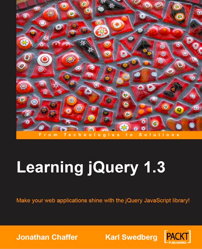 Learning jQuery 1.3 (US | UK) is one of the most famous books about jQuery, the popular JavaScript framework.
Learning jQuery 1.3 (US | UK) is one of the most famous books about jQuery, the popular JavaScript framework.
It's written by Karl Swedberg and Jonathan Chaffer, and published by Packt.
This book is an introduction to the jQuery framework, specifically the release 1.3. It teaches you how to use the JavaScript framework in your site, how to use existing plugins and extend the jQuery core library creating custom plugins.
My two cents
One of the aspects of the book I appreciate the most is the number of examples. You don't have to wait more than ten pages to see the first example of a HTML page enriched by a jQuery effect. Examples are clear, effective and they never overshadow the narration.
Also, this book is not merely a learn-by-example publication. The authors never delegate to the example the role of teaching you how to learn jQuery but they always use them in support of the theoretical explanation. The risk of learn-by-example books is that, at the end, you are just able to reproduce what the examples show you without having a global mastery of the argument.
The books dedicates only two chapters to plugins: the first on using plugins and the second on developing plugins. Whilst the list of jQuery plugins continue to grow up and it's impossible to keep a book up-to-date with it, I would have appreciated a more deep overview about authoring a plugin.
I would have appreciate some page about plugin best practices, suggestions and plugin development patterns.
Audience
You don't have to be a JavaScript master to read this book, though some JavaScript skills might be helpful. Moreover, a basic programming knowledge can help you to better understand the examples. Quite obviously, you need a good HTML and CSS knowledge.
If you want to leverage your JavaScript skills, jump to Appendix C. It offers a really interesting overview about Closures: what they are and how you can use them to your advantage. Reading this section before the other chapters can make the difference later, when you'll have to understand the usage of anonymous functions and callbacks in the examples throughout the book.
If you are looking for a JavaScript reference, this isn't the book for you. Remember, this book covers the jQuery JavaScript framework, not the JavaScript language.
If you are an user interface designer or interaction designer, the first part teaches you how to alter the structure of an HTML document attaching or moving page elements, fire off behaviors responding to user events and interact with server-side functionalities. If you are a programmer, the third part offers some precious suggestions to package your scripts making your code more reusable and maintainable.
Regardless your activity, if you are looking for a book to better understand how jQuery works, Learning jQuery is definitely a recommended reading.
Structure
The book is implicitly divided into tree parts:
- The first part, from chapter 1 to 6, provides an introduction to the framework. You'll learn the philosophy behind jQuery, how to use it and how jQuery can help you to write more powerful user interactions.
- The second part, from chapter 7 to 9, contains several real-world examples, pulling together what you've learned in the previous part. Most of the examples are actually overtaken by existing jQuery plugins, however creating something from scratch it's an important training and it forces you to have your finger in the pie.
- The third part, from chapter 10 to 11, shows you how to extend the jQuery core library using existing plugins or creating and packaging your own extensions.